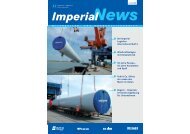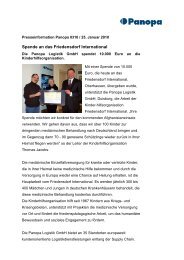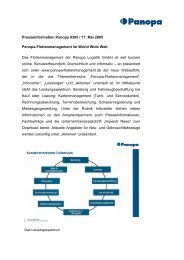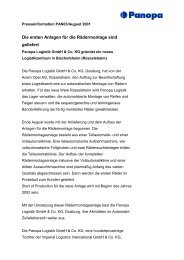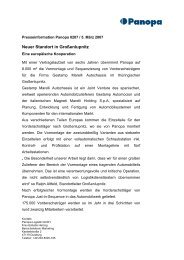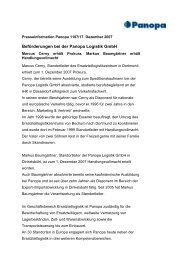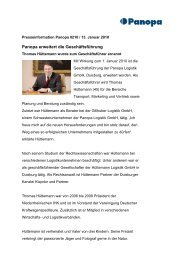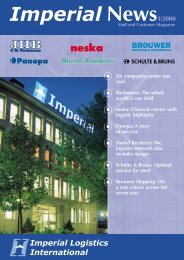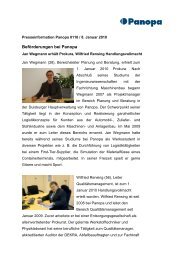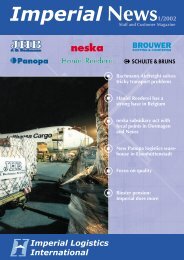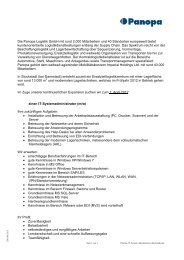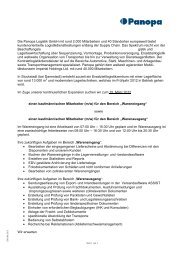Create successful ePaper yourself
Turn your PDF publications into a flip-book with our unique Google optimized e-Paper software.
course, the indispensable deployment<br />
of trucks for short<br />
and long-distance shipments.<br />
We link these carriers<br />
and providers and take care<br />
of cargo handling and temporary<br />
storage. And that’s<br />
not all: handling container<br />
cargo involves additional<br />
tasks related to customs and<br />
safety and not every container<br />
goes through the terminal<br />
FCL, i.e. full and closed, but<br />
also LCL (less than container<br />
load). Outgoing containerisation<br />
is carried out<br />
here on behalf of the customers<br />
- this includes stuffing<br />
general cargo in the CTS<br />
terminal buildings. Conversely,<br />
incoming containers<br />
are opened and unloaded<br />
(stripped ) and individual<br />
lots are delivered to the recipients<br />
after freight for-<br />
warding processing. This<br />
business is increasing and<br />
we gear ourselves to this development<br />
through investments.<br />
Here again CTS does not<br />
see itself as a freight forwarder,<br />
but as a neutral<br />
provider whose services can<br />
be made use of by everyone<br />
in the sector. „The facilities<br />
we have at our disposal<br />
make us a valuable partner<br />
and we try to live up to this<br />
role every day,“ assures co-<br />
Managing Director Karl-<br />
Heinz Schoon.<br />
Wieland assesses the present<br />
and future positively.<br />
The sectors oriented to foreign<br />
trade that are primarily<br />
represented in the Cologne<br />
region, i.e. motor vehicle<br />
production, parts manufacturing,<br />
suppliers and the<br />
neska<br />
The CTS terminal in Köln-Diehl is served according to<br />
schedule by container trains of various companies.<br />
chemical industry, as well as<br />
prospering small and medium-sized<br />
enterprises and the<br />
importing retail and wholesale<br />
trade generate a rising<br />
cargo volume that is stowed<br />
in containers and finds its<br />
way to the buyers via CTS<br />
facilities.<br />
Everything is not a surefire<br />
success, of course.<br />
Wieland and his sales team<br />
are untiring in their efforts<br />
at making the CTS services<br />
known to shipping and<br />
freight forwarding companies.<br />
In many places local<br />
presence is shown so as to<br />
be able to meet customer demands<br />
quickly and consistently.<br />
The endeavours have<br />
been worthwhile: from 1999<br />
to 2000 container handling<br />
movements rose by 12 percent<br />
to 180,000. In the cur-<br />
rent year the 200,000 mark<br />
can be reached. The first<br />
weeks started off well.<br />
For a terminal in an inland<br />
port these are impressive<br />
figures that draw the attention<br />
of all providers of<br />
transport services, such as<br />
truckers, DB Cargo subsidiary<br />
Transfracht and inland<br />
waterway shipping<br />
companies, and thus lead to<br />
a high density of service.<br />
For example, several seaport-based<br />
night operations<br />
by rail, frequent inland waterway<br />
vessel runs and<br />
bustling freight forwarding<br />
Several CTS reach stackers ensure flexibility in the<br />
handling of containers and semitrailers.<br />
traffic by truck. „All of this<br />
is concentrated at CTS and<br />
spurs me and my staff to<br />
continue to expand business,“<br />
reaffirms Hans-Peter<br />
Wieland. �<br />
IMPERIAL NEWS � 13



